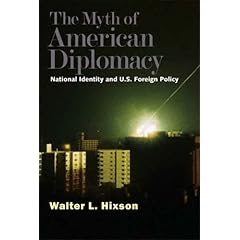The Myth of American Diplomacy
 The Myth of American Diplomacy emphasizes that U.S. foreign policy emanates from a culture of patriotic national identity. As the book derives from secondary sources, depends on theory for its essential arguments, and takes heed of the notion that the United States has functioned as a “beacon of liberty,” it is likely to generate controversy among historians and the general public.
The Myth of American Diplomacy emphasizes that U.S. foreign policy emanates from a culture of patriotic national identity. As the book derives from secondary sources, depends on theory for its essential arguments, and takes heed of the notion that the United States has functioned as a “beacon of liberty,” it is likely to generate controversy among historians and the general public.
The book argues that a hegemonic national identity, which I have conceptualized (borrowing from historian Sacvan Bercovitch) as the “Myth of America,” drives a remarkably continuous foreign policy characterized by militancy and the regular resort to war. Focusing on the entire sweep of U.S. diplomacy, the book links foreign policy with the imagined community of the nation. I argue that the discourses and representations of national identity—concepts such as Manifest Destiny and the Free World, symbols such as the American Flag, holidays like the Fourth of July, and much more—drive a continuous foreign policy characterized by violence, militarism, and choosing war, especially in times of psychic crisis. Aggression against foreign enemies simultaneously enables containment of domestic subversives, thereby affirming hegemonic national identity while at the same time marginalizing progressive reform on the home front.
By adopting post-modern methodology, the book challenges historians to use their knowledge to enter more forcefully into a broader discussion of the character of U.S. foreign policy. Put another way, the book seeks to deconstruct the Myth of America as a prelude to reconstructing a new and more progressive international diplomacy. I do not seek to denigrate empirical scholarship—indeed, the entire book is built on that very foundation of secondary works—but to show its limitations and illuminate ways in which historians can exert greater influence on national foreign policy. Although the book does not compare the United States with other nations, I do attempt to place the history of U.S. foreign policy within comparative contexts of modernity, imperialism, and post-colonialism.
Taking a very long view, the narrative history begins with European settlement of the Atlantic world and the gradual emergence of a distinctly American imagined community within the wider context of modernity. Race, gender, religious, and to a lesser extent class discourses defined and affirmed American national identity. Ethnic cleansing of Indians—the first enemy-others—permeated the entire process of nation building and left a deep imprint on national identity and foreign policy. This process played out through the nineteenth century and carried into the wars of the twentieth century, particularly in Asia.
The Myth of American Diplomacy analyzes entry into all the major wars of U.S. history and argues that the United States typically chose war rather than engaging in national defense. Adopting the trope popularized by Richard Hofstadter, the book argues that the decision to go to war often came at times of acute psychic crisis. The regular resort to war thus may be viewed as pathological. Even World War II, the proverbial “good war,” was more of a war of American choosing than most people realize because the “day of infamy” frame crowds out a closer reading of the road to war with Japan as well as the prewar U.S. preoccupation with containing Bolshevism rather than European fascism.
The book perceives continuity in U.S. foreign policy toward the post-colonial world. Flowing logically from the heavily raced discourses of domestic slavery and ethnic cleansing of Indians, the United States viewed nations in Latin America, Asia, and Africa as racially inferior and ripe for intervention. Tropes of manliness, and godliness, as well as race, sanctioned the Mexican War, conquest of the Philippines, the Vietnam War, and other conflicts. A chapter entitled Neo-colonial Nightmares casts a critical eye on post-World War II U.S. foreign policy in the “Third World.”
The so-called Cold War provides an excellent frame for deconstructive analysis. While events of the Cold War such as the Berlin Blockade or the Cuban Missile Crisis were most “real,” the frame “Cold War” was a cultural construction fueled by powerful discourses and representations. As in World War II, mythical national identity pitted the United States as waging a death struggle between good and evil in a righteous war against godless communism. The Cold War gave rise to the modern warfare state, simultaneously burying the legacy of the New Deal and justifying a powerful wave of counter-subversion, dubbed McCarthyism in traditional historical discourse.
Just as World War I fostered disillusion and a relatively brief flourishing of non-interventionist discourse (demonized as “isolationism”), the Vietnam debacle ignited protest and contributed to the rise of a subversive counter-culture. The second to last chapter explores the cultural process of counter-subversive containment, marginalization of liberal reform, and the patriotic revival of the 1980s. The final narrative chapter places the Persian Gulf War, the Arab-Israeli conflict, and September 11 in the context of continuous militant national identity, including Orientalist discourse and “line in the sand” manliness, culminating in the “global war on terror” at a time of pronounced psychic crisis.
The brief final chapter calls for historians to engage more directly in unpacking the hegemonic discourse under-girding U.S. foreign policy. Only then can a new hegemony of cooperative internationalism displace the militant foreign policy that ha characterized the United States throughout its history.